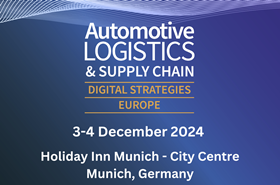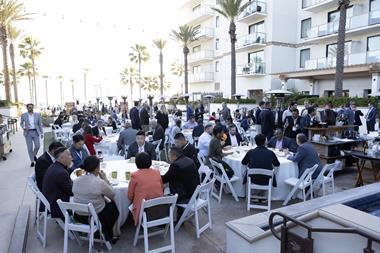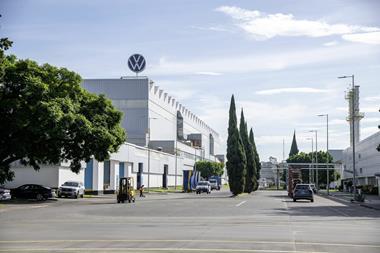Toyota Motor Europe’s digitalisation strategy involves collaboration, precision and leveraging its mega hub to move into performance mode.

Jean-Christophe Deville, vice-president of supply chain, Toyota Motor Europe (TME) took to the stage at the Automotive Logistics & Supply Chain Europe 2024 conference in Munich, Germany to discuss vehicle logistics, operational improvement and customer satisfaction.
He said that in the last few years, TME’s supply chain has been in “survival mode”, and now the OEM wants to move its supply chain into performance mode. “Digitalisation is one of the enablers for us to get into a situation where we systematically perform everywhere,” he said, adding that the OEM wants to reinforce its mantra of being “on time, in time, every time”.
Read more: Follow our live blog from ALSC Digital Strategies Europe for the latest news and insights
Last month, the carmaker inaugurated the €17m ($18m) Toyota vehicle distribution mega hub in Kolín, Czech Republic, which processes 350,000 vehicles annually. Now, Deville says the mega hub is incorporating digital strategies to move into this performance mode.
One way of doing this is through taking option-fitting inhouse using Toyota Production Systems Technology.
“Historically we used to give the option fitting activities to one of our logistics partners with a service agreement, but the option fitting is becoming more and more complex,” Deville said. “Our logistics partners are very good at logistics and transportations, and with Toyota we have a proven history in assembling and making cars, so we thought about how we can get the best of both worlds. So, we’ve decided that option fittings, anything that is to do with the vehicle itself, should be done by Toyota people with the Toyota Production Systems methodology.”

To help put this into place, TME introduced digital ‘eInstructions’, so that Toyota’s workforce can be guided through the daily activities they need to complete and confirm step-by-step what has been done.
“That helps us to see if they struggle, and then the team leaders can step in to understand what the problem is, if it’s ergonomics, the load, the sequence,” he said. “So how do we improve these situations? With this we already see the results of a quality hub. The members do not miss any more steps, the productivity is Increasing and our members feedback is that they are very happy about it.”
Read more: How Toyota is using digital tools to restock US dealer vehicle inventories
Using these eInstructions, Toyota can quickly train members of its workforce without requiring travel, saving time and expense, and in turn increasing customer and worker satisfaction.
He said: “The time for us to introduce the options and make that available to customers is much faster. We’re talking in hours or days instead of weeks to go for new options across Europe. The merit is for our members here and very much for our customers.”
Deville added that the Toyota ethos also plays a big role in accepting new technologies and systems of working, which is another reason that option fitting was taken inhouse. He said that Toyota’s motto is actually on the outside of the mega hub building. “That’s what our people commit every morning when they pass the door. that’s what our people commit every morning when they pass the door,” he said.
Toyota Motor Europe introduces Project Velos
Deville also announced that Toyota Motor Europe has developed Velos planning software in collaboration with Inform to improve visibility and efficiency in vehicle logistics planning.
Project Velos provides Toyota with advanced tools to map out its logistics network, identify bottlenecks and forecast stock levels across various locations. The software allows Toyota to move beyond manual simulations and reliance on Excel spreadsheets, Deville said.
This system enables Toyota and its logistics partners to anticipate transportation requirements and allocate resources more effectively, thereby improving the accuracy of estimated arrival times (ETAs) and overall customer satisfaction. A key feature of Project Velos is its ability to prioritise vehicle movements dynamically, moving beyond the traditional first-in, first-out approach to ensure that vehicles reach their destinations in alignment with customer needs.
By integrating confirmed lead times from logistics partners, rather than relying on historical data, Project Velos enhances the precision of transportation planning and execution within Toyota’s European supply chain.
”It’s a transportation plan driven by confirmed capacity from the logistic partners,” Deville said.
Experts from VW, Audi, BMW, Catena-X, Toyota, JLR, Infineon, CATL, Mercedes-Benz, SEAT, Daimler Truck and more gathered on stage at this year’s Automotive Logistics & Supply Chain Digital Strategies Europe, which took place 3-4 December in Munich, Germany.
The speakers discussed how to form a more co-creative, resilient and sustainable supply chain, providing insights into using the latest digital advancements to tackle uncertainty, volatility and cost pressures. Follow our recap blog to get insights, news and Red Sofa video interviews from the event.


























![Global[1]](https://d3n5uof8vony13.cloudfront.net/Pictures/web/a/d/s/global1_726550.svgz)














No comments yet